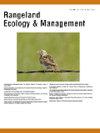将 "下沉式灌木丛保护设计 "推广到地方保护规划的互动工具
IF 2.4
3区 环境科学与生态学
Q2 ECOLOGY
引用次数: 0
摘要
为保护美国西部的鼠尾草生物群落所做的努力是巨大的,但栖息地的丧失和退化目前已经超过了集体保护的努力。由整个生物群落的科学家和管理者共同制定的 "鼠尾草保护设计"(Sagebrush Conservation Design,SCD)发出了紧急行动呼吁,要求从根本上重新确定保护工作的优先次序,以拯救该生物群落。SCD 的核心是 "保护和发展核心 "战略,即优先保护具有原生林下植物且威胁程度较低的完整鼠尾草地区,而不是像往常一样处理所有威胁或将重点放在威胁最严重的地区。然而,SCD 的应用受限于土地管理者将牧场状况和威胁地图纳入其管理区域规划过程的能力。为了加强空间数据的整合,帮助管理者和规划者将 SCD 缩减为地方尺度的保护规划,我们开发了一个网络应用程序,提供了一个用户友好的界面。在此,我们为网络应用程序用户提供了一份指南,希望它能帮助土地管理者做出战略性保护决策,从而最好地保护鼠尾草生物群落。本文章由计算机程序翻译,如有差异,请以英文原文为准。
An Interactive Tool to Promote Stepping Down the Sagebrush Conservation Design to Local Conservation Planning
Conservation efforts for the sagebrush biome in the western United States have been significant, but habitat loss and degradation are currently outpacing collective conservation efforts. The Sagebrush Conservation Design (SCD), cocreated by scientists and managers working across the biome, issues an urgent call to action to radically reprioritize conservation efforts to save the biome. At the heart of SCD is the “defend and grow the core” strategy, which means prioritizing conservation in intact sagebrush areas with native understories and low levels of threats, as opposed to the business-as-usual approach of treating all threats or focusing on areas with the most severe threats. However, SCD applications are limited by the capacity of land managers to integrate maps of rangeland conditions and threats into planning processes for their management area. To increase the integration of spatial data and help managers and planners step down SCD to local-scale conservation planning, we developed a web application that provides a user-friendly interface. Here, we lay out a guide for web application users, which we hope will empower land managers to make strategic conservation decisions that best protect the sagebrush biome.
求助全文
通过发布文献求助,成功后即可免费获取论文全文。
去求助
来源期刊

Rangeland Ecology & Management
农林科学-环境科学
CiteScore
4.60
自引率
13.00%
发文量
87
审稿时长
12-24 weeks
期刊介绍:
Rangeland Ecology & Management publishes all topics-including ecology, management, socioeconomic and policy-pertaining to global rangelands. The journal''s mission is to inform academics, ecosystem managers and policy makers of science-based information to promote sound rangeland stewardship. Author submissions are published in five manuscript categories: original research papers, high-profile forum topics, concept syntheses, as well as research and technical notes.
Rangelands represent approximately 50% of the Earth''s land area and provision multiple ecosystem services for large human populations. This expansive and diverse land area functions as coupled human-ecological systems. Knowledge of both social and biophysical system components and their interactions represent the foundation for informed rangeland stewardship. Rangeland Ecology & Management uniquely integrates information from multiple system components to address current and pending challenges confronting global rangelands.
 求助内容:
求助内容: 应助结果提醒方式:
应助结果提醒方式:


